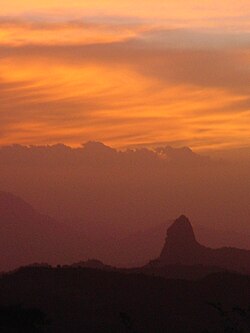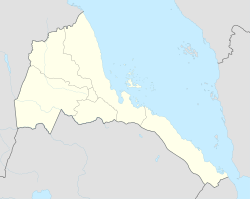Agordat (also spelled Akordat or Ak'ordat) is a city in Gash-Barka, Eritrea. It was the capital of the former Barka Province, which was situated between the present-day Gash-Barka and Anseba regions.
Agordat
Ak'ordat | |
|---|---|
Town | |
 Sunset between Agordat and Keren | |
 Map of Agordat in Eritrea | |
| Coordinates: 15°33′N 37°53′E / 15.550°N 37.883°E | |
| Country | Eritrea |
| Region | Gash-Barka |
| Time zone | UTC+3 (EAT) |
| Climate | BWh |
History edit
Excavations in Agordat uncovered pottery related to the C-Group (Temehu) pastoral culture, which inhabited the Nile Valley between 2500 and 1500 BC.[1] Sherds akin to those of the Kerma culture, another community that flourished in the Nile Valley around the same period, were also found at other local archaeological sites in the Barka valley belonging to the Gash Group.[2][3][4]
Agordat was the last major town along the Eritrean Railway to Massawa through Asmara. The line continued on through to Bishia, its terminus. The local economy is reliant on passing traders moving between Asmara and Kessela in Sudan.
Overview edit
Agordat lies in the western part of the country on the Barka River. An important market town and it also home to a large mosque. Agordat has many restaurants, as well as a hospital built during the colonial period in Italian Eritrea. A considerable amount of Eritrea's fruit and vegetables, particularly bananas and oranges, are transported through the town. Additionally, the Akat fruit is grown locally.
Climate edit
Ak'ordat has a hot arid climate (Köppen BWh) with hot to sweltering temperatures throughout the year and a short wet season from mid-June to mid-September due to the northward extension of the West African Monsoon and the African Easterly Jet.
| Climate data for Ak'ordat | |||||||||||||
|---|---|---|---|---|---|---|---|---|---|---|---|---|---|
| Month | Jan | Feb | Mar | Apr | May | Jun | Jul | Aug | Sep | Oct | Nov | Dec | Year |
| Mean daily maximum °C (°F) | 32 (89) |
33 (92) |
36 (96) |
39 (103) |
40 (104) |
37 (99) |
33 (91) |
32 (89) |
35 (95) |
37 (99) |
36 (96) |
33 (92) |
35 (95) |
| Mean daily minimum °C (°F) | 14 (58) |
14 (57) |
14 (58) |
18 (65) |
22 (72) |
22 (72) |
21 (69) |
21 (70) |
21 (69) |
21 (70) |
19 (67) |
16 (61) |
19 (66) |
| Average rainfall mm (inches) | 0 (0) |
0 (0) |
0 (0) |
0 (0) |
10 (0.4) |
30 (1.2) |
100 (3.9) |
140 (5.5) |
40 (1.6) |
0 (0) |
0 (0) |
0 (0) |
320 (12.6) |
| Source: Weatherbase [5] | |||||||||||||
See also edit
References edit
- ^ Cole, Sonia Mary (1964). The Prehistory of East. Weidenfeld & Nicolson. p. 273.
- ^ Leclant, Jean (1993). Sesto Congresso internazionale di egittologia: atti, Volume 2. International Association of Egyptologists. p. 402. Retrieved 15 September 2014.
- ^ Marianne Bechaus-Gerst; Roger Blench (2014). Kevin MacDonald (ed.). The Origins and Development of African Livestock: Archaeology, Genetics, Linguistics and Ethnography - "Linguistic evidence for the prehistory of livestock in Sudan" (2000). Routledge. p. 453. ISBN 978-1135434168. Retrieved 15 September 2014.
- ^ Behrens, Peter (1986). Libya Antiqua: Report and Papers of the Symposium Organized by Unesco in Paris, 16 to 18 January 1984 - "Language and migrations of the early Saharan cattle herders: the formation of the Berber branch". Unesco. p. 30. ISBN 9231023764. Retrieved 14 September 2014.
- ^ "Weatherbase: Historical Weather for Ak'ordat, Eritrea". Weatherbase. 2011. Retrieved on November 24, 2011.
15°33′N 37°53′E / 15.550°N 37.883°E
